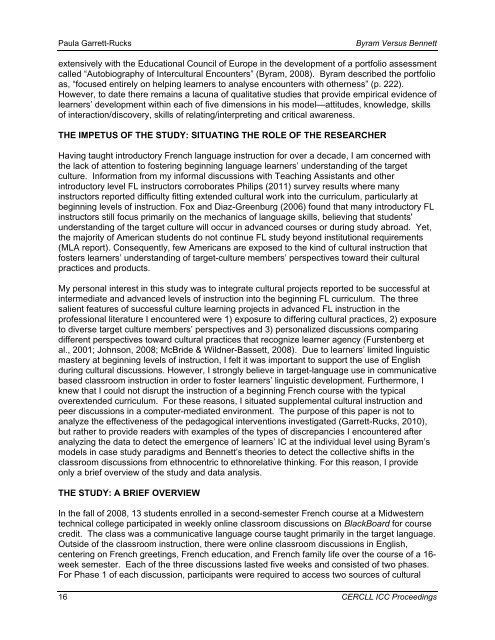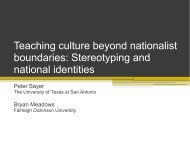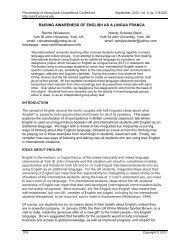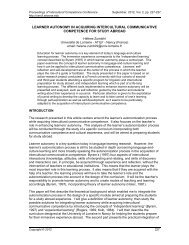BYRAM VERSUS BENNETT: DISCREPANCIES IN THE ... - CERCLL
BYRAM VERSUS BENNETT: DISCREPANCIES IN THE ... - CERCLL
BYRAM VERSUS BENNETT: DISCREPANCIES IN THE ... - CERCLL
You also want an ePaper? Increase the reach of your titles
YUMPU automatically turns print PDFs into web optimized ePapers that Google loves.
Paula Garrett-Rucks Byram Versus Bennett<br />
extensively with the Educational Council of Europe in the development of a portfolio assessment<br />
called “Autobiography of Intercultural Encounters” (Byram, 2008). Byram described the portfolio<br />
as, “focused entirely on helping learners to analyse encounters with otherness” (p. 222).<br />
However, to date there remains a lacuna of qualitative studies that provide empirical evidence of<br />
learners’ development within each of five dimensions in his model—attitudes, knowledge, skills<br />
of interaction/discovery, skills of relating/interpreting and critical awareness.<br />
<strong>THE</strong> IMPETUS OF <strong>THE</strong> STUDY: SITUAT<strong>IN</strong>G <strong>THE</strong> ROLE OF <strong>THE</strong> RESEARCHER<br />
Having taught introductory French language instruction for over a decade, I am concerned with<br />
the lack of attention to fostering beginning language learners’ understanding of the target<br />
culture. Information from my informal discussions with Teaching Assistants and other<br />
introductory level FL instructors corroborates Philips (2011) survey results where many<br />
instructors reported difficulty fitting extended cultural work into the curriculum, particularly at<br />
beginning levels of instruction. Fox and Diaz-Greenburg (2006) found that many introductory FL<br />
instructors still focus primarily on the mechanics of language skills, believing that students'<br />
understanding of the target culture will occur in advanced courses or during study abroad. Yet,<br />
the majority of American students do not continue FL study beyond institutional requirements<br />
(MLA report). Consequently, few Americans are exposed to the kind of cultural instruction that<br />
fosters learners’ understanding of target-culture members’ perspectives toward their cultural<br />
practices and products.<br />
My personal interest in this study was to integrate cultural projects reported to be successful at<br />
intermediate and advanced levels of instruction into the beginning FL curriculum. The three<br />
salient features of successful culture learning projects in advanced FL instruction in the<br />
professional literature I encountered were 1) exposure to differing cultural practices, 2) exposure<br />
to diverse target culture members’ perspectives and 3) personalized discussions comparing<br />
different perspectives toward cultural practices that recognize learner agency (Furstenberg et<br />
al., 2001; Johnson, 2008; McBride & Wildner-Bassett, 2008). Due to learners’ limited linguistic<br />
mastery at beginning levels of instruction, I felt it was important to support the use of English<br />
during cultural discussions. However, I strongly believe in target-language use in communicative<br />
based classroom instruction in order to foster learners’ linguistic development. Furthermore, I<br />
knew that I could not disrupt the instruction of a beginning French course with the typical<br />
overextended curriculum. For these reasons, I situated supplemental cultural instruction and<br />
peer discussions in a computer-mediated environment. The purpose of this paper is not to<br />
analyze the effectiveness of the pedagogical interventions investigated (Garrett-Rucks, 2010),<br />
but rather to provide readers with examples of the types of discrepancies I encountered after<br />
analyzing the data to detect the emergence of learners’ IC at the individual level using Byram’s<br />
models in case study paradigms and Bennett’s theories to detect the collective shifts in the<br />
classroom discussions from ethnocentric to ethnorelative thinking. For this reason, I provide<br />
only a brief overview of the study and data analysis.<br />
<strong>THE</strong> STUDY: A BRIEF OVERVIEW<br />
In the fall of 2008, 13 students enrolled in a second-semester French course at a Midwestern<br />
technical college participated in weekly online classroom discussions on BlackBoard for course<br />
credit. The class was a communicative language course taught primarily in the target language.<br />
Outside of the classroom instruction, there were online classroom discussions in English,<br />
centering on French greetings, French education, and French family life over the course of a 16week<br />
semester. Each of the three discussions lasted five weeks and consisted of two phases.<br />
For Phase 1 of each discussion, participants were required to access two sources of cultural<br />
16 <strong>CERCLL</strong> ICC Proceedings





